Abstract
5-Ethynyluracil (5-EU, 776C85) is a mechanism-based irreversible inhibitor of dihydropyrimidine dehydrogenase (EC 1.3.1.2), the rate-determining enzyme in 5-fluorouracil (5-FU) catabolism. In the present study, 5-EU was found to be a potent modulator of 5-FU catabolism in mice and rats. Liver extracts prepared up to 6 hr after a 5-EU dose (2 mg/kg) were > 96% inhibited in their ability to catalyze 5-FU degradation. 5-EU treatment increased the elimination t1/2 and the area under the plasma concentration-time curve of 5-FU. 5-FU oral bioavailability was approximately 100% in rats pretreated with 5-EU. Consequently, 5-EU induced a linear relationship between the area under the plasma concentration-time curve and the oral dose of 5-FU. As expected from the preservation of plasma 5-FU, 5-EU potentiated the antitumor activity and the toxicity of 5-FU in two mouse tumor models (Colon 38 and MOPC-315). However, 5-EU potentiated the antitumor activity to a greater degree and thereby increased the therapeutic index of 5-FU 2- to 4-fold.
Full text
PDF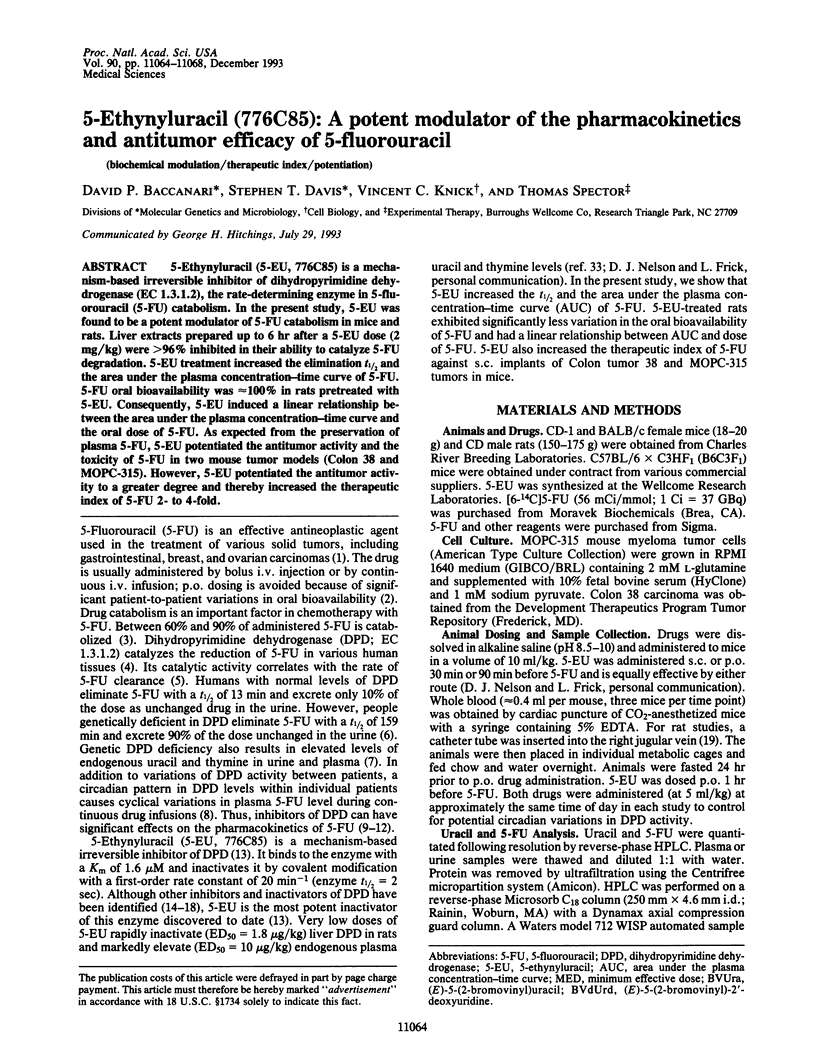
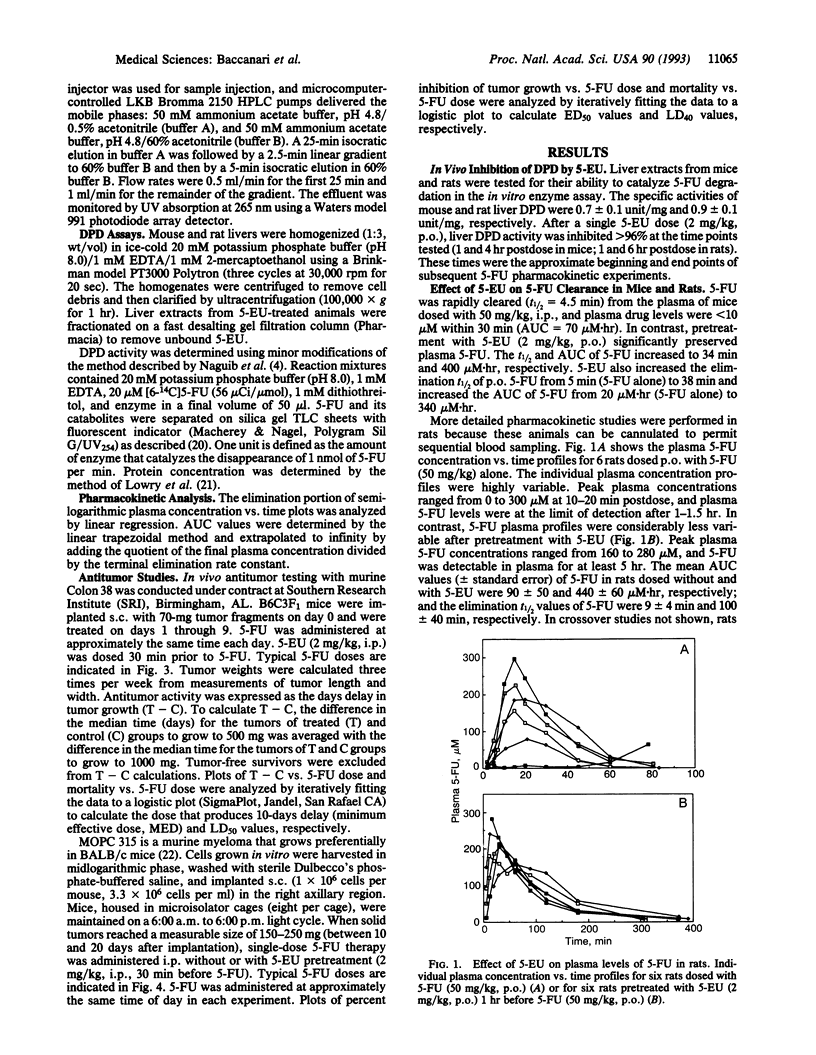
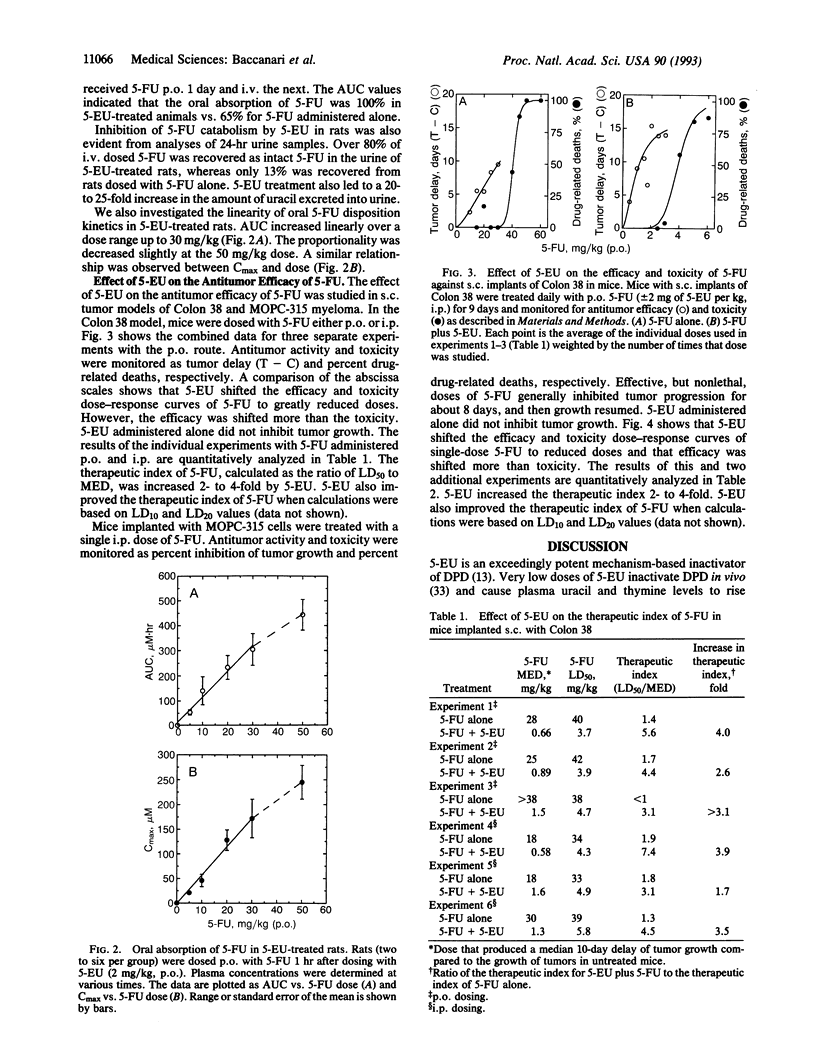
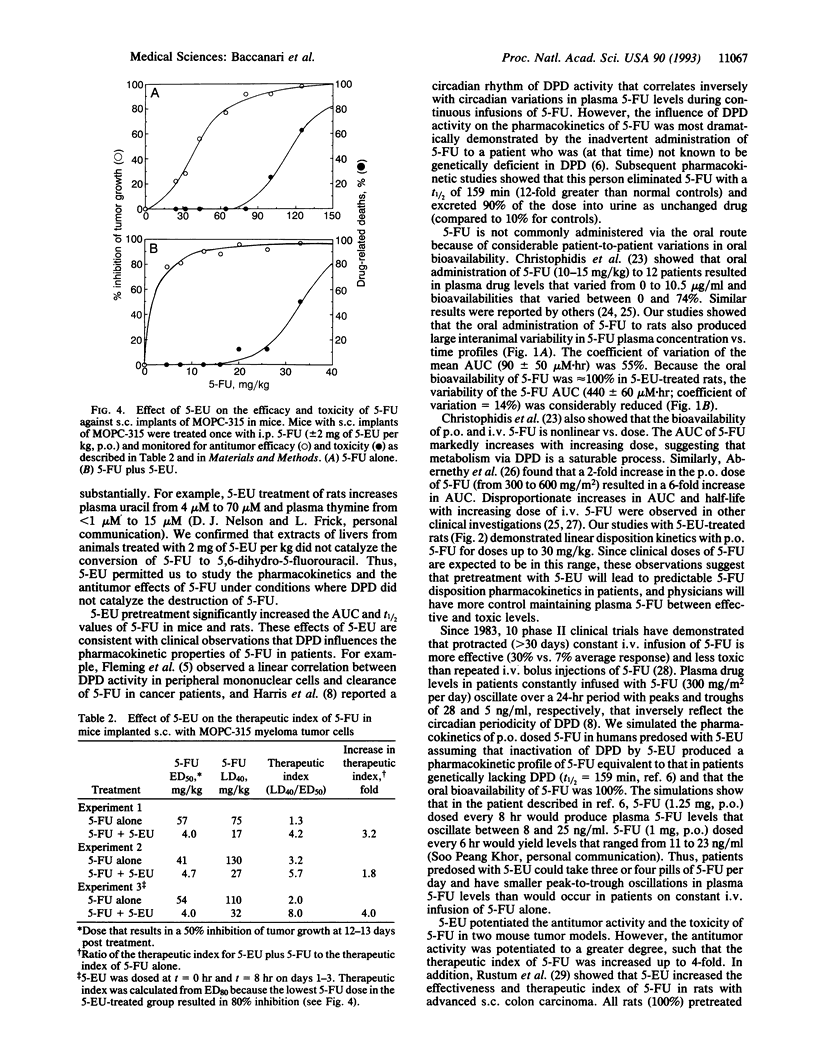
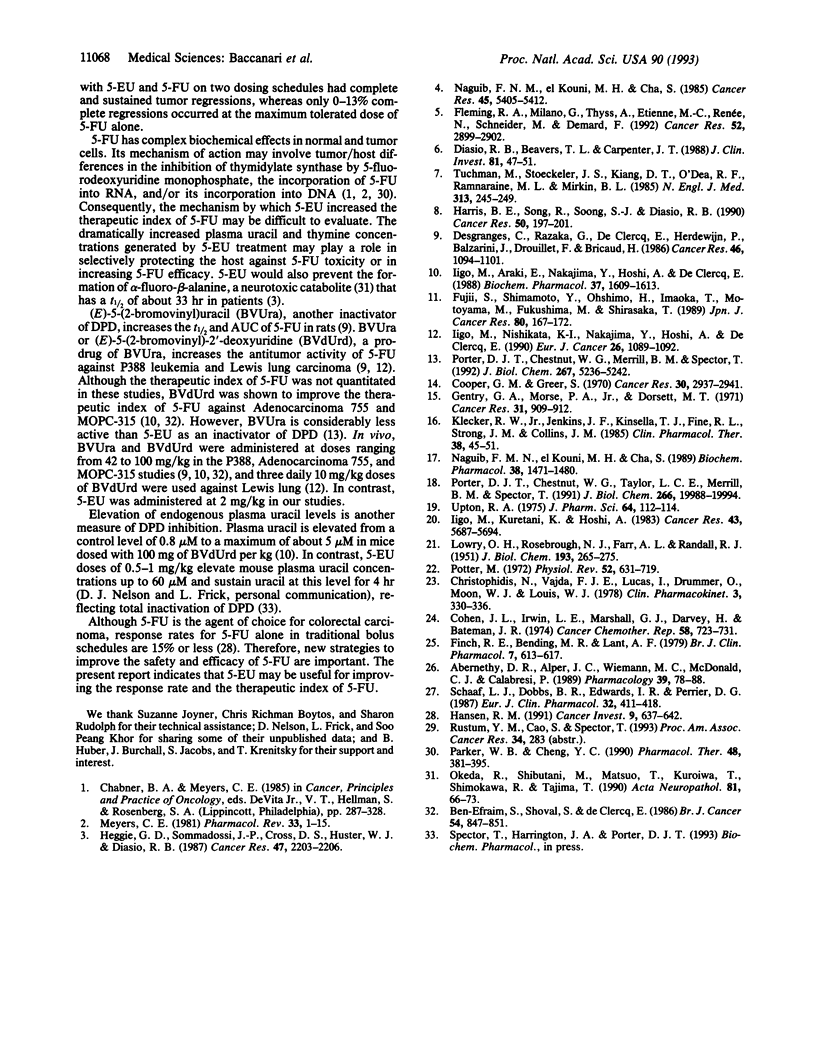
Selected References
These references are in PubMed. This may not be the complete list of references from this article.
- Abernethy D. R., Alper J. C., Wiemann M. C., McDonald C. J., Calabresi P. Oral 5-fluorouracil in psoriasis: pharmacokinetic-pharmacodynamic relationships. Pharmacology. 1989;39(2):78–88. doi: 10.1159/000138581. [DOI] [PubMed] [Google Scholar]
- Ben-Efraim S., Shoval S., de Clercq E. Enhancing effect of bromovinyldeoxyuridine on antitumour activity of 5-fluorouracil in mice bearing MOPC-315 plasmacytomas. Br J Cancer. 1986 Nov;54(5):847–851. doi: 10.1038/bjc.1986.250. [DOI] [PMC free article] [PubMed] [Google Scholar]
- Chirstophidis N., Vajda F. J., Lucas I., Drummer O., Moon W. J., Louis W. J. Fluorouracil therapy in patients with carcinoma of the large bowel: a pharmacokinetic comparison of various rates and routes of administration. Clin Pharmacokinet. 1978 Jul-Aug;3(4):330–336. doi: 10.2165/00003088-197803040-00006. [DOI] [PubMed] [Google Scholar]
- Cohen J. L., Irwin L. E., Marshall G. J., Darvey H., Bateman J. R. Clinical pharmacology of oral and intravenous 5-fluorouracil (NSC-19893). Cancer Chemother Rep. 1974 Sep-Oct;58(5 Pt 1):723–731. [PubMed] [Google Scholar]
- Cooper G. M., Greer S. Irreversible inhibition of dehalogenation of 5-iodouracil by 5-diazouracil and reversible inhibition by 5-cyanouracil. Cancer Res. 1970 Dec;30(12):2937–2941. [PubMed] [Google Scholar]
- Desgranges C., Razaka G., De Clercq E., Herdewijn P., Balzarini J., Drouillet F., Bricaud H. Effect of (E)-5-(2-bromovinyl)uracil on the catabolism and antitumor activity of 5-fluorouracil in rats and leukemic mice. Cancer Res. 1986 Mar;46(3):1094–1101. [PubMed] [Google Scholar]
- Diasio R. B., Beavers T. L., Carpenter J. T. Familial deficiency of dihydropyrimidine dehydrogenase. Biochemical basis for familial pyrimidinemia and severe 5-fluorouracil-induced toxicity. J Clin Invest. 1988 Jan;81(1):47–51. doi: 10.1172/JCI113308. [DOI] [PMC free article] [PubMed] [Google Scholar]
- Finch R. E., Bending M. R., Lant A. F. Plasma levels of 5-fluorouracil after oral and intravenous administration in cancer patients. Br J Clin Pharmacol. 1979 Jun;7(6):613–617. doi: 10.1111/j.1365-2125.1979.tb04651.x. [DOI] [PMC free article] [PubMed] [Google Scholar]
- Fleming R. A., Milano G., Thyss A., Etienne M. C., Renée N., Schneider M., Demard F. Correlation between dihydropyrimidine dehydrogenase activity in peripheral mononuclear cells and systemic clearance of fluorouracil in cancer patients. Cancer Res. 1992 May 15;52(10):2899–2902. [PubMed] [Google Scholar]
- Fujii S., Shimamoto Y., Ohshimo H., Imaoka T., Motoyama M., Fukushima M., Shirasaka T. Effects of the plasma concentration of 5-fluorouracil and the duration of continuous venous infusion of 5-fluorouracil with an inhibitor of 5-fluorouracil degradation on Yoshida sarcomas in rats. Jpn J Cancer Res. 1989 Feb;80(2):167–172. doi: 10.1111/j.1349-7006.1989.tb02285.x. [DOI] [PMC free article] [PubMed] [Google Scholar]
- Gentry G. A., Morse P. A., Jr, Dorsett M. T. In vivo inhibition of pyrimidine catabolism by 5-cyanouracil. Cancer Res. 1971 Jun;31(6):909–912. [PubMed] [Google Scholar]
- Hansen R. M. 5-Fluorouracil by protracted venous infusion: a review of recent clinical studies. Cancer Invest. 1991;9(6):637–642. doi: 10.3109/07357909109039875. [DOI] [PubMed] [Google Scholar]
- Harris B. E., Song R., Soong S. J., Diasio R. B. Relationship between dihydropyrimidine dehydrogenase activity and plasma 5-fluorouracil levels with evidence for circadian variation of enzyme activity and plasma drug levels in cancer patients receiving 5-fluorouracil by protracted continuous infusion. Cancer Res. 1990 Jan 1;50(1):197–201. [PubMed] [Google Scholar]
- Heggie G. D., Sommadossi J. P., Cross D. S., Huster W. J., Diasio R. B. Clinical pharmacokinetics of 5-fluorouracil and its metabolites in plasma, urine, and bile. Cancer Res. 1987 Apr 15;47(8):2203–2206. [PubMed] [Google Scholar]
- Iigo M., Araki E., Nakajima Y., Hoshi A., De Clercq E. Enhancing effect of bromovinyldeoxyuridine on antitumor activity of 5-fluorouracil against adenocarcinoma 755 in mice. Increased therapeutic index and correlation with increased plasma 5-fluorouracil levels. Biochem Pharmacol. 1988 Apr 15;37(8):1609–1613. doi: 10.1016/0006-2952(88)90025-1. [DOI] [PubMed] [Google Scholar]
- Iigo M., Kuretani K., Hoshi A. Relationship between antitumor effect and metabolites of 5-fluorouracil in combination treatment with 5-fluorouracil and guanosine in ascites sarcoma 180 tumor system. Cancer Res. 1983 Dec;43(12 Pt 1):5687–5694. [PubMed] [Google Scholar]
- Iigo M., Nishikata K., Nakajima Y., Hoshi A., De Clercq E. Effect of (E)-5-(2-bromovinyl)-2'-deoxyuridine on life-span and 5-fluorouracil metabolism in mice with hepatic metastases. Eur J Cancer. 1990;26(10):1089–1092. doi: 10.1016/0277-5379(90)90058-2. [DOI] [PubMed] [Google Scholar]
- Klecker R. W., Jr, Jenkins J. F., Kinsella T. J., Fine R. L., Strong J. M., Collins J. M. Clinical pharmacology of 5-iodo-2'-deoxyuridine and 5-iodouracil and endogenous pyrimidine modulation. Clin Pharmacol Ther. 1985 Jul;38(1):45–51. doi: 10.1038/clpt.1985.132. [DOI] [PubMed] [Google Scholar]
- LOWRY O. H., ROSEBROUGH N. J., FARR A. L., RANDALL R. J. Protein measurement with the Folin phenol reagent. J Biol Chem. 1951 Nov;193(1):265–275. [PubMed] [Google Scholar]
- Myers C. E. The pharmacology of the fluoropyrimidines. Pharmacol Rev. 1981 Mar;33(1):1–15. [PubMed] [Google Scholar]
- Naguib F. N., el Kouni M. H., Cha S. Enzymes of uracil catabolism in normal and neoplastic human tissues. Cancer Res. 1985 Nov;45(11 Pt 1):5405–5412. [PubMed] [Google Scholar]
- Naguib F. N., el Kouni M. H., Cha S. Structure-activity relationship of ligands of dihydrouracil dehydrogenase from mouse liver. Biochem Pharmacol. 1989 May 1;38(9):1471–1480. doi: 10.1016/0006-2952(89)90187-1. [DOI] [PubMed] [Google Scholar]
- Okeda R., Shibutani M., Matsuo T., Kuroiwa T., Shimokawa R., Tajima T. Experimental neurotoxicity of 5-fluorouracil and its derivatives is due to poisoning by the monofluorinated organic metabolites, monofluoroacetic acid and alpha-fluoro-beta-alanine. Acta Neuropathol. 1990;81(1):66–73. doi: 10.1007/BF00662639. [DOI] [PubMed] [Google Scholar]
- Parker W. B., Cheng Y. C. Metabolism and mechanism of action of 5-fluorouracil. Pharmacol Ther. 1990;48(3):381–395. doi: 10.1016/0163-7258(90)90056-8. [DOI] [PubMed] [Google Scholar]
- Porter D. J., Chestnut W. G., Merrill B. M., Spector T. Mechanism-based inactivation of dihydropyrimidine dehydrogenase by 5-ethynyluracil. J Biol Chem. 1992 Mar 15;267(8):5236–5242. [PubMed] [Google Scholar]
- Porter D. J., Chestnut W. G., Taylor L. C., Merrill B. M., Spector T. Inactivation of dihydropyrimidine dehydrogenase by 5-iodouracil. J Biol Chem. 1991 Oct 25;266(30):19988–19994. [PubMed] [Google Scholar]
- Potter M. Immunoglobulin-producing tumors and myeloma proteins of mice. Physiol Rev. 1972 Jul;52(3):631–719. doi: 10.1152/physrev.1972.52.3.631. [DOI] [PubMed] [Google Scholar]
- Schaaf L. J., Dobbs B. R., Edwards I. R., Perrier D. G. Nonlinear pharmacokinetic characteristics of 5-fluorouracil (5-FU) in colorectal cancer patients. Eur J Clin Pharmacol. 1987;32(4):411–418. doi: 10.1007/BF00543978. [DOI] [PubMed] [Google Scholar]
- Tuchman M., Stoeckeler J. S., Kiang D. T., O'Dea R. F., Ramnaraine M. L., Mirkin B. L. Familial pyrimidinemia and pyrimidinuria associated with severe fluorouracil toxicity. N Engl J Med. 1985 Jul 25;313(4):245–249. doi: 10.1056/NEJM198507253130407. [DOI] [PubMed] [Google Scholar]
- Upton R. A. Simple and reliable method for serial sampling of blood from rats. J Pharm Sci. 1975 Jan;64(1):112–114. doi: 10.1002/jps.2600640123. [DOI] [PubMed] [Google Scholar]


